 Albrecht Dürer, Self-Portrait in Fur, 1500 Munich, Alte Pinakothek
Albrecht Dürer, Self-Portrait in Fur, 1500 Munich, Alte Pinakothek
Albrecht Dürer was born in Nuremberg, Germany in 1471. He was the third son of Albrecht Dürer the Elder and Barbara Holper. His father was a renowned goldsmith and master at the Nuremberg Goldsmiths' Guild, while his mother came from a wealthy family in the city.
From an early age, Dürer showed a talent for drawing. At the age of fourteen, he became an apprentice to Michael Wolgemut, a famous painter and printmaker from Nuremberg. For three years Dürer worked in Wolgemut's studio, learning the basics of painting, printmaking and drawing.
First trips and encounters
After completing his apprenticeship with Michael Wolgemut in Nuremberg, Albrecht Dürer undertook a trip to Colmar, France to meet Martin Schongauer, a famous engraver of the time. Dürer studied Schongauer's etchings and was influenced by his style.
Back in Nuremberg, Dürer opened his own studio and quickly gained a reputation as a talented artist. In 1494 he married Agnes Frey, the daughter of a wealthy brick maker.
In 1495, Dürer left for Venice, where he met Andrea Mantegna, a famous artist of the Italian Renaissance. Dürer was impressed with Mantegna's paintings and studied his oil painting techniques.
Dürer was also influenced by the art of Giovanni Bellini, another Venetian artist, and worked with him on several projects. While in Venice, Dürer produced numerous woodcuts and copperplate engravings, as well as oil paintings.
After returning to Nuremberg in 1495, Dürer continued to produce high quality works of art and gained recognition in Europe. He was widely regarded as one of the greatest artists of his time.
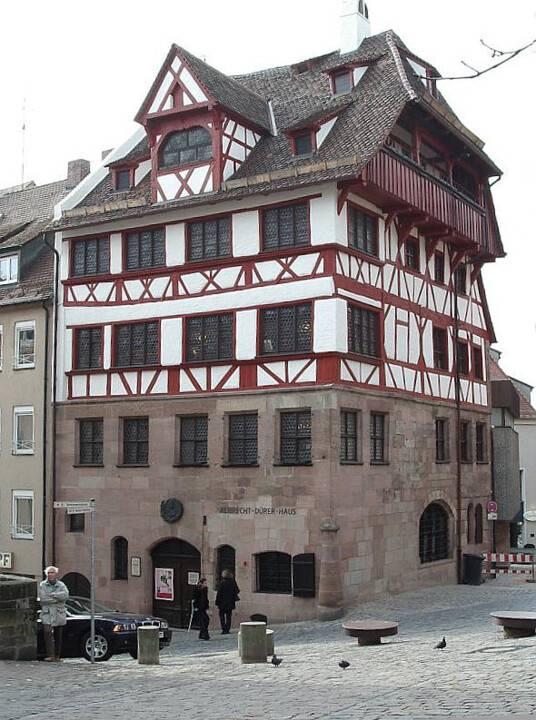 Dürer's house in Nuremberg (Germany)
Dürer's house in Nuremberg (Germany)
The Nuremberg period
Nuremberg was a prosperous and influential city during the Renaissance, and it was in this context that Albrecht Dürer's studio opened its doors. Dürer quickly gained a reputation as a talented artist and attracted many patrons.
The rise of the city also contributed to the development of Dürer's workshop. Wealthy Nuremberg merchants were generous patrons and financially supported local artists. Thanks to this support, Dürer was able to produce some of his most famous works, such as "La Melencolia I" and "The Knight, Death and the Devil".
In 1505 Dürer undertook his second journey to Italy, where he was welcomed by the wealthy merchants of the Fugger family. While there, he studied the works of Leonardo da Vinci and Raphael, and worked on new projects.
Back in Nuremberg, Dürer found new patrons and continued to produce high-quality works of art. He has been involved in many projects, such as creating works for churches and institutions in the city. His fame continued to grow and he became one of the most famous artists of his time.
Patrons of Dürer
Willibald Pirckheimer – a close friend of Dürer and a famous humanist from Nuremberg, who purchased many of Dürer's artworks and helped fund some of his projects.
Jakob Heller – a wealthy merchant who commissioned a famous painting of the Apocalypse from Dürer for his private chapel.
Members of the Fugger family - one of the wealthiest and most influential families in Europe at the time, who hosted Dürer on his second trip to Italy and worked with him on several projects.
Maximilian I, Holy Roman Emperor, who also commissioned works of art from Dürer.
The Prince-Elector of Saxony, Frederick III of Saxony, was also one of Albrecht Dürer's important patrons. The Prince-Elector was a great art lover and commissioned several works from Dürer, including a painting of the Madonna and Child which was donated to Meissen Cathedral. Dürer also made a portrait engraving of Frederick III
The last years in Nuremberg
During his last years in Nuremberg, Albrecht Dürer continued to produce exceptional works of art while working on his treatises on measure and proportion. He also trained apprentices in his workshop. Unfortunately, Dürer's health began to fail and he died on April 6, 1528, at the age of 56. He was buried in the cemetery of St. John's Church in Nuremberg, where a monument to his honor was erected in 1622. His home in Nuremberg is now a museum dedicated to his life and work.
Dürer and the Reformation
Albrecht Dürer lived during a period of significant social and religious change in Europe, notably the Protestant Reformation. Although not known to have been an active religious activist, he was influenced by Reformation ideas and was friends with humanists like Willibald Pirckheimer. Some of Dürer's works were also influenced by Reformation ideas, notably his woodcut "The Virgin and Child with the Four Angels" (1518), which depicts the Virgin Mary and Jesus as ordinary human beings, rather than in a sacred context. This more realistic depiction was seen as a break from the established artistic traditions of the time.
Dürer also produced illustrations for religious books, including engravings for the Bible and works by Martin Luther. These illustrations were used to promote the ideas of the Reformation to the public and had an impact on the dissemination of religious texts throughout Europe.
6 incongruous things to know about Albrecht Dürer
He was passionate about rabbits: Dürer loved rabbits so much that he had several as pets in his workshop. He also painted several portraits of rabbits and made engravings, including a famous one entitled "The Hare".
He had health problems: Dürer suffered from various illnesses throughout his life, including stomach pain, migraines and dizziness. He also experienced a period of depression in the middle of his career.
He invented a typewriter: Dürer was a prolific inventor and created several machines, including a typewriter, called "Schreibmaschine".
He loved puns: Dürer was known for his puns and puzzles. He published a book called "The Proverbs" which contained illustrations of German proverbs accompanied by riddles.
He drew a unicorn: Although best known for his realistic portraits, Dürer also drew mythical creatures, such as a unicorn. This illustration became very popular and was reproduced on tapestries and fabrics.
He was passionate about mathematics: Dürer was fascinated by mathematics and wrote several treatises on measurement and proportion. His research on perspective also influenced his artistic technique and helped make him one of the most innovative artists of his time.
The works of Albrecht Dürer
Gouaches and watercolors
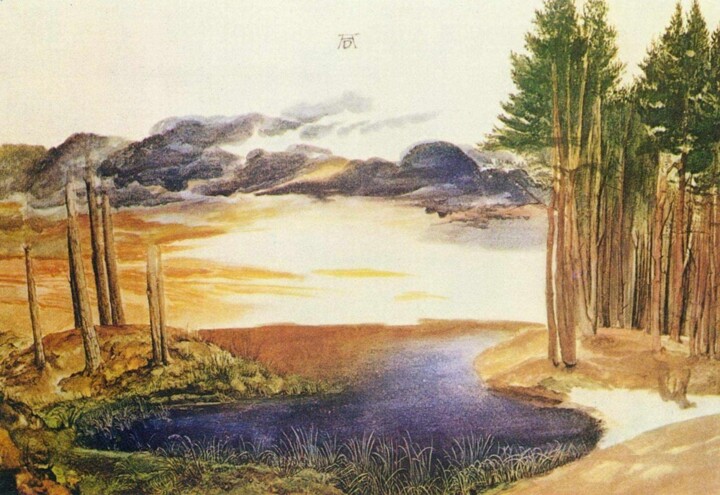 Albrecht Dürer, A pond in the forest, watercolor and gouache on paper around 1497
Albrecht Dürer, A pond in the forest, watercolor and gouache on paper around 1497
Albrecht Dürer marked the history of Western art by making the first landscape watercolor depicting a precise view, a considerable advance in the use of this technique. During his trip through the Alps, Dürer also produced several remarkable watercolors, according to the researchers, which can be classified into two categories based on botanical criteria.
The first watercolors were made on the outward journey to Venice in the autumn of 1494, while the others were created in the spring of 1495 on the way back, after Dürer had discovered Italian painting. Scholars have noted an important differentiation between these two categories, with distinct styles that can be explained by Dürer's own evolution and interest in landscape prints. Although most of the watercolours, with the exception of the View of Innsbruck, were done on the outward journey, these paintings were still notable for their precision.
The portraits
Dürer's portraits are more than just physical representations, they are also psychological descriptions. The painter often uses himself as a model, as well as those close to him, such as his wife Agnès or his parents. Around 1500, his drawn portraits are highly sought after and often include inscriptions. Dürer was then one of the greatest portrait painters of his time and developed a unique style in Venice, for relatively small portraits. His portrait drawings may eventually be used for painting, but most exist for themselves. During his trip to the Netherlands, he produced a large number of them, often given as gifts or exchanged for a bed or dinner, or kept in his travel diary.
Dürer began engraving portraits late in his career. During the Empire Diet of Augsburg in 1518, he dealt extensively with portraits, painted or drawn, of all the personalities of the Empire who wanted to be represented by the great painter of the time. From this series, he draws his first engraved portrait of a contemporary, Cardinal Albrecht von Brandenburg, known as the “Little Cardinal”.
Dürer is not the first to engrave portraits, but he uses the chisel to give his portraits psychological finesse and physical precision. Until 1526, he executed five large chisel portraits of eminent personalities of his time, such as Albrecht von Brandenburg, the elector of Saxony Frederick the Wise, his lifelong friend, Willibald Pirkheimer, the theologian Philipp Melantchon and Erasmus Rotterdam. Only one xylography, that of Ulrich Varnbüler, surprises with its imposing format and its treatment as vigorous as plastic. These late engraved portraits of recognized figures definitively place Dürer at the center of humanist Europe, that of intellectual, spiritual, political and artistic exchanges. They could be distributed widely and compete with medals, in particular by being less expensive.
The self-portraits
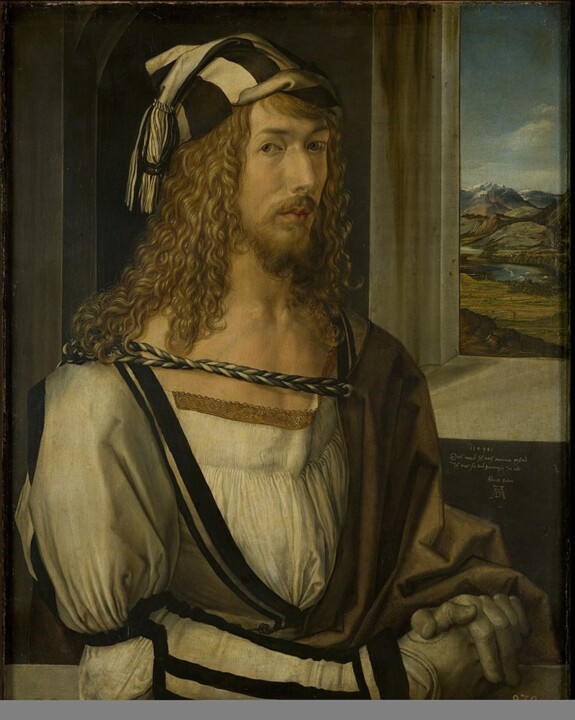 Albrecht Dürer, Self-portrait, oil on wood panel, 1498
Albrecht Dürer, Self-portrait, oil on wood panel, 1498
Albrecht Dürer was the first to make a large number of self-portraits in painting and drawing, showing great self-assurance and pride. Although he sought to leave a glorious trace of his life, his self-portraits also let his emotions and state of mind shine through. The oldest surviving self-portrait dates from when he was 13 years old. His Self-Portrait with Gloves from 1498 shows him dressed as a Venetian nobleman, aware of his worth and rank. The portrait he made two years later, in Germany, shows a painter in a more religious form, probably to indicate that he is following the way of the Lord. Dürer takes a distance from reality in his self-portraits, organizing a theatrical staging and not trying to show who he really is. He also affirms his status as an artist by regularly slipping into his works, as in The Virgin of the Rosary Day or the Landauer Altarpiece.
Nature
Dürer, a great observer of nature, has a deep interest in its wonders. He does not just describe it literally, but often imprints a deeper meaning on it. For him, nature is both a source of inspiration and a practical exercise. He captures in his drawings real pieces of nature that he occasionally reuses in other compositions.
From the 15th century, Flemish painting or that of Cologne took a marked interest in the representation of the living and the real, and Dürer made it an omnipresent protagonist in his images. He was marked very early on by the landscapes he encountered during his travels in the Alps or around Nuremberg.
Watercolor is his preferred medium for depicting the changing light of his panoramic landscapes, totally recomposed to serve as the background for his most famous engravings. The use of mathematical perspective adds a believable rendering of a nature in reality completely recomposed by the engraving. Dürer is also interested in previously unseen animal subjects, such as dead animals, which intrigue him. His engraving of the Rhinoceros presents the power and the monumentality of the animal occupying the entire sheet, heightened by the framing carefully chosen by the artist.
Engraving
Michael Wolgemut, Dürer's master, was involved in the production of two xylographic works: Stephan Fridolin's Schatzbehalter (or Religious Treasure) in 1491 and The Nuremberg Chronicle, a kind of historical summary published in 1493 with six hundred and fifty-two woodcuts comprising three hundred different characters. From the start of his career, Dürer stood out from the Nuremberg tradition by using the chisel for copper engraving and by raising wood engraving to the rank of art. He attaches great importance to his signature, thus affirming the notion of artistic property. Although he perfectly mastered the technique of chisel engraving, he delegated wood engraving to other artists. He appropriated the etching process invented by Daniel Hopfer around 1500 and produced six etchings between 1515 and 1518. He was also the first to use drypoint exclusively for three of his compositions in 1512. Quattrocento engravers, such as the Master of the E series of the so-called Mantegna Tarots, Andrea Mantegna and Antonio Pollaiuolo, as well as the Master of the Book of Reason, are sources of inspiration for Dürer. His fame comes from two series of woodcuts, a Small Passion of 37 engravings and a Great Passion of 15 engravings, as well as a copper-engraved Passion, a Life of Mary of 19 woodcuts and a title sheet, and especially The Apocalypse gathering 15 woodcuts plus a title sheet. Dürer serves as a reference for the Italian and Nordic engravers who follow him, such as Jacopo de' Barbari, Giulio Campagnola, Marc-Antoine Raimondi, Georg Pencz and the brothers Barthel Beham and Hans Sebald Beham.
The marketing of works
Dürer used peddlers for the marketing of his works. This method of sale was very common at the time and allowed artists to reach a large audience, even outside the major cultural centers. Peddlers were itinerant merchants who traveled the roads and lanes to sell their wares, including Dürer's prints and etchings. They were often the only means for art lovers to discover the works of renowned artists of the time.
The theoretical work of Durer
The theoretical work of Albrecht Dürer is important for understanding his artistic approach. He is particularly interested in mathematics and perspective, seeking to establish rules for representing space realistically. In his work Underweysung der Messung mit dem Zirckel und Richtscheyt (Treatise on measurement using the compass and ruler) published in 1525, he set out his theories on geometry and proportion, as well as on the construction of the human figure. . This book had a great influence on the artists of his time and the following centuries, helping to spread the principles of the Renaissance in Europe.
Dürer was also interested in color theory and in 1504 published a work entitled De symmetria partium in rectis formis humanorum corporum (On the symmetry of parts in the straight forms of human bodies). He develops a theory of color based on the complementarity of colors and the notion of simultaneous contrast. This theory is applied in his works, notably in the series of woodcuts La Grande Passion where he uses color contrasts to reinforce dramatic expression.
Finally, Dürer is interested in theology and philosophy, seeking to reconcile his Christian faith with the humanist ideas of his time. In his work Four Books on Human Proportion published in 1528, he addresses issues related to beauty, perfection and divine creation, seeking to establish rules for representing the human figure in an ideal way. These theoretical works show the intellectual dimension of Dürer's work, which goes far beyond the strictly artistic framework.
Dürer's influence in contemporary culture
Art: Many contemporary artists are inspired by Dürer's work, such as the American photographer Chuck Close who created a series of portraits based on the mathematical proportions of Dürer's canon. German painter Gerhard Richter has also said that Dürer's work had an influence on his work.
Cinema: In the film "Pan's Labyrinth" by Guillermo del Toro, the main character Ofelia is obsessed with an engraving of Dürer's Apocalypse. Ron Howard's film "The Da Vinci Code" also contains a Dürer reference in which the main character discovers a secret map hidden in one of his engravings.
Literature: In the novel "The Name of the Rose" by Umberto Eco, the main character Guillaume de Baskerville refers to Dürer and his work on mathematical proportions in art. In "The Painting of the Flemish Master" by Arturo Pérez-Reverte, the main character is an art expert who is responsible for authenticating a work attributed to Dürer.
Television: In the series "Penny Dreadful", the main character Vanessa Ives visits an art exhibition and admires an engraving by Dürer. The "Black Sails" series also references Dürer in a scene where main character John Silver uses one of his engravings to conceal a treasure map.
Quotes from Albrecht Dürer:
- "Art is the highest degree of hope."
- "I've never seen anything uglier than me."
- "Men of genius are meteors destined to burn to light up their century."
- "Beauty is in the proportions."
- "Painting is silent poetry, and poetry speaking painting."
- "Any work of art is a child of its time and, often, the mother of our feelings."
- "Ignorance of art could not be better defined than by ignorance of geometry."
- "Drawing is the probity of art."
- "Time is a great master, they say. The misfortune is that it kills its pupils."
- "The aim of all music should be to soften manners and make them better."
Dürer's most famous works
The Great Passion and The Little Passion: Two series of woodcuts depicting the life of Christ, considered masterpieces of printmaking.
The Apocalypse: A series of 16 woodcuts representing the prophecies of the Apocalypse according to Saint John.
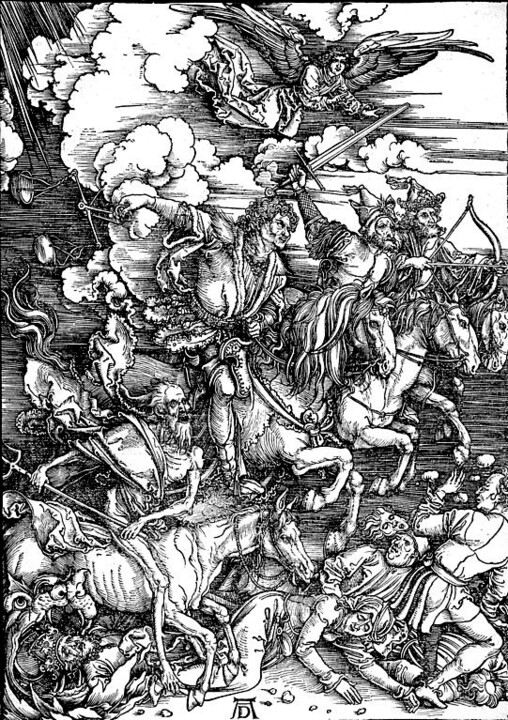
Albrecht Dürer, The Four Horsemen of the Apocalypse, woodcut, between 1497 and 1498The Knight, Death and the Devil: A copperplate engraving depicting a horseman crossing Death and the Devil on his way, an allegory of spiritual struggle.
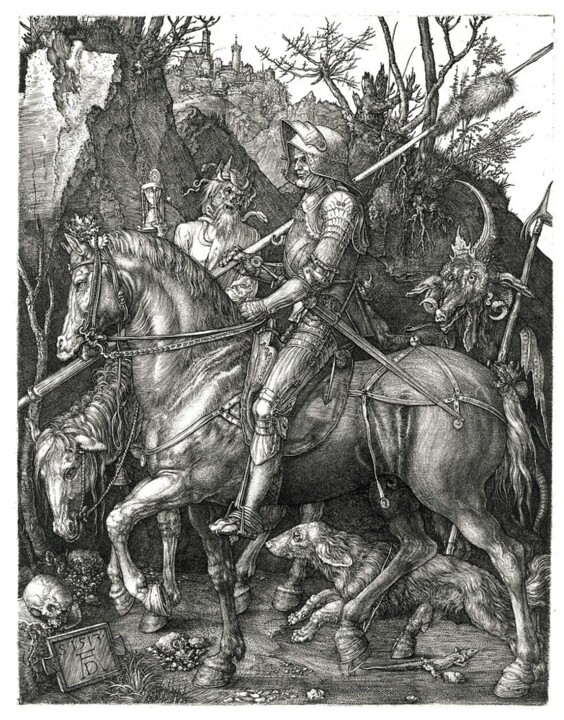
Albrecht Dürer, The Knight, Death and the Devil, 1513, copper engravingMelencolia I: An intricate and symbolic copperplate engraving depicting melancholy, one of Dürer's best-known works.

Albrecht Dürer, Melancolia, 1514, copper engravingFurry Self-Portrait: A portrait of Dürer himself, clad in fur and with an introspective expression.
The Virgin and Child with Saint Anne: A painting depicting the Virgin Mary, the Child Jesus and her mother Anne, considered a masterpiece of painting.
Rhinoceros: A famous engraving representing a rhinoceros, exotic for the time, which Dürer had never seen in person.

Albrecht Dürer, Rhinoceros, 1515, woodcutPortrait of Emperor Maximilian I: A grandiose portrait of Emperor Maximilian I, executed with great precision and impressive attention to detail.
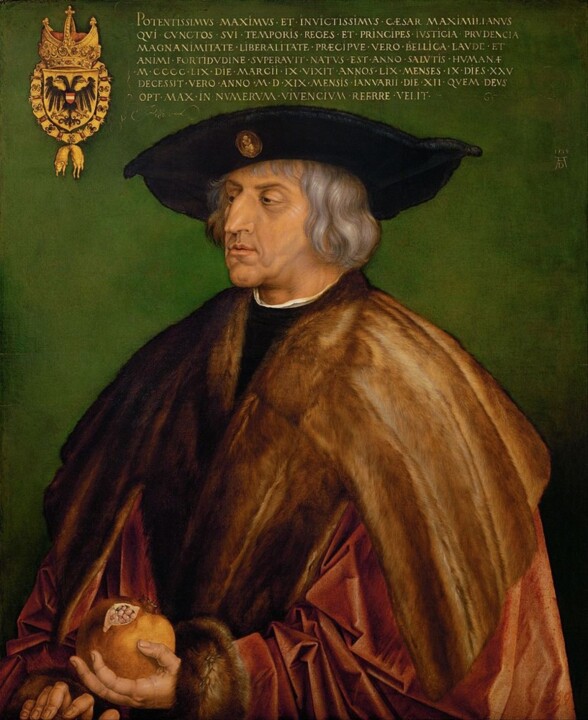
Albrecht Dürer, Portrait of Emperor Maximilian I, 1519, Oil on panelThe Young Hare: A watercolor depicting a hare, an example of Dürer's mastery of animal drawing.
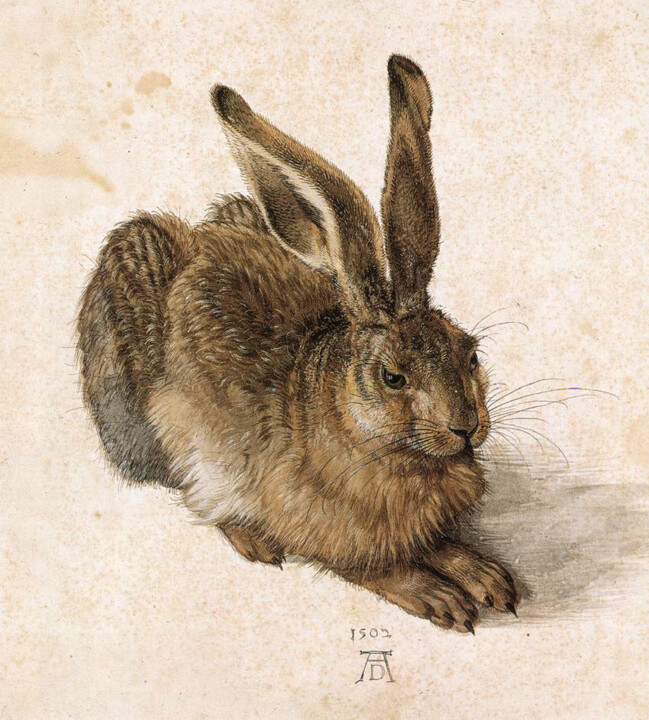
Albrecht Dürer, The Hare, 1502, WatercolorThe Martyrdom of the Ten Thousand: An engraving depicting the martyrdom of the Ten Thousand Christians at Mount Ararat, an example of Dürer's interest in religious subjects and battle scenes.

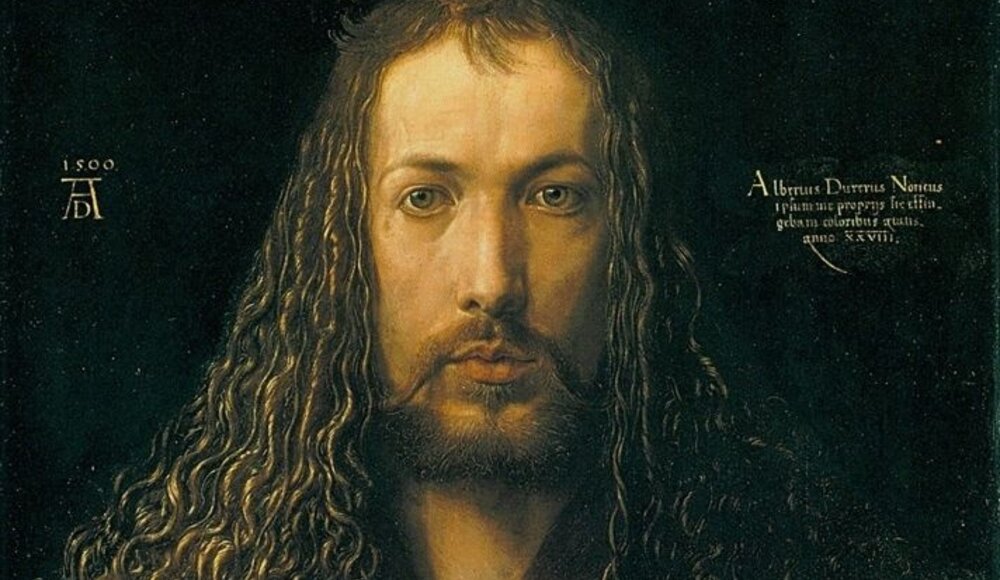
 Jean Dubreil
Jean Dubreil